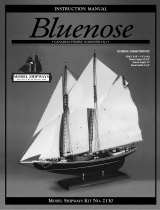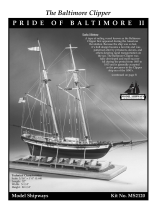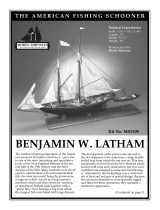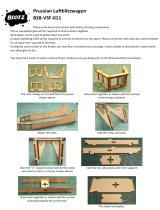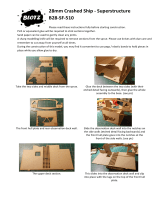Page is loading ...

Wire mesh
Wire (thick)
Wire (thin)
Incised plate x 2
Plate x 2
Plate x 2
Strakes
• Sandpaper (grain
no. 800 and 400)
• Craft knife
• Set-square
• Fast-drying normal
and wood glue
• Metal file
• Electrician’s pliers
• Double-sided
adhesive tape
• Putty
• Cutters
•Awl (diameter
0.5mm, 1mm)
• Pliers
• Metal primer
• Battleship grey spray
paint
• Model-making
watercolour paint
(battleship grey, matt
white and black)
• For metal: Super
Glue Gel or Two-part
epoxy glue
• Wooden spatula
• Paintbrush
Recommended tools and materials
Air vents on the base of the bridge, the antenna of
the main guns command post
and strakes
6
Prepare the edges of the
command bridge completed
so far and, with fast-drying glue,
fix a vent in the position shown
in the photo. Be careful to align
the edges with the right and top
of the bridge. Similarly, fix the
other vent to the opposite side.
5
Spray the vents with battleship
grey paint. When they are
completely dry, paint all the
cavities in pieces 4with equal
parts of battleship grey and matt
black watercolour paint.
4
Put putty into the edges of
the air vents. Take a small
amount and work it in with the
end of a wooden spatula. When
the putty is completely dry,
smooth with folded sandpaper
to remove any excess.
When using spray paint, ventilate the room well.
When using spray paint, ventilate the room well.
2
Smooth one piece 5with
sandpaper grain no. 800. With
the craft knife, cut two rectangles
measuring 8x13mm from the wire
mesh 1, and then free the two pieces
4. On one side of 5, fix a rectangle of
mesh with fast-drying glue, and fix it
onto 4. Repeat the operation to make
the second air vent.
3
Smooth the edges of the two
vents with the metal file and
sandpaper no. 400, eliminating the
excess. Round off the edges,
checking them with those of
pieces 4.
1
Spray the metal primer evenly on
two pieces 5from a distance of
30cm. The operation will be easier
if you fix the pieces to a base with
double-sided adhesive tape.
AIR VENTS ON THE BASE OF THE BRIDGE AND ANTENNA
OF THE MAIN GUNS COMMAND POST
Yamato: Step-by-step 73

12
Similarly, make a 1mm
hole with the awl on
the side of the main guns
command post at the
point shown in
Figure C.
7
Bend piece 2as shown in letter
‘e’ in Figure A. Make the shape
using your fingers and electrician’s
pliers. Then cut the ends with the
pliers and smooth with a metal file.
10
Glue a ring ‘f ’ to the end of
piece ‘d’, with the opening
downwards, as shown in the photo.
Through the opening, insert the
second ring ‘f’ in the first, so that
they are perpendicular to one
another. Glue them at the point of
contact. This piece is the tip of the
antenna.
11
Take the guns command
post, assembled in Step 38,
Despatch 3, as shown in the
photo, and make a 0.5mm-
diameter hole with the awl at the
point indicated in Figure B.
Before doing so, mark the
position with a pin.
9
With the remaining parts of 3,
form the two rings ‘f’ as shown
in Figure A. To make them, wrap
the wire twice around a rod 2mm
in diameter. Remove the rod and
cut the two rings using the pliers.
14
Put piece ‘a’ between
piece ‘e’ and the guns
command post, as shown in
the photo, and fix it firmly
with metal glue (refer to the
drawing in the circle in
Step 18).
13
Put metal glue on the
lower end of piece ‘e’
and insert it into the hole
made in Step 12, positioning it
in the direction shown in the
photos and gluing it firmly
(refer to the drawing in the
circle in Step 18).
15
Put metal glue on the
lower end of the
antenna (pieces ‘d’ and ‘f’) and
fix it firmly, inserting it into
the hole made in Step 11 (refer
to the drawing in the circle in
Step 18).
16
Place piece ‘c’ between
the tip of the antenna
and piece ‘a, piece ‘b’ between
the tip of the antenna and the
guns command post, as shown
in the photo, and check against
the drawing in the circle of
Step 18. Take care to fix firmly.
3mm
B
1.5mm
C
c
f
c
e
d
b
a
A
Actual size
8
Make four segments from piece
3, shaping them as shown by
letters ‘a’, ‘b’, ‘c’ and ‘d’ in Figure A.
Slightly cut at the bends with the
metal file (see photo below) to
obtain sharper angles.
a
Yamato: Step-by-step 74

18
When it is thoroughly dry,
paint the end of piece ‘e’ for
2mm from the tip with
matt white
watercolour.
17
With the tip of a paintbrush,
evenly paint pieces ‘a’, ‘b’, ‘c’,
‘d’ and ‘e’ with battleship grey
watercolour.
21
Place a strake 7from the
14th to the 18th frames.
First, adjust the length of the
strake and then fix it with fast-
drying wood glue, aligning the
upper left edge with the upper
edge of the stern deck.
22
After adjusting the
length, glue another
strake 7below the one fixed in
the previous step. Fill any spaces
between the two strakes 7just
fixed with leftovers of a strake.
Apply glue to the sides of the
two strakes, and insert the
leftovers, without worrying
about unevenness.
20
Take the body of the ship, as
shown in the photo, and with
fast-drying wood glue fix one of the
pieces 6(Figure E) above frames nos.
16 and 17 on the top edge of the
stern. The diagonally cut side of
piece 6must point toward the stern.
In the same way, fix the other piece 6
on the opposite side.
23
Let the glue dry
thoroughly, then remove
protruding parts with the craft
knife. Pass the blade along the
body of the ship several times, as
if drawing a line.
19
Cut the two pieces 6with
the craft knife to obtain the
shape shown in Figure D.
24
Fill the space between the
16th and 18th frames
under piece 6fixed in Step 20
with two strakes 7. First, adjust
the length of the two strakes and
then glue them. Fill any spaces
left in the manner described in
Steps 22 and 23.
25
Take a strake with a
slanting upper side (Figure
F) and fill the space between the
12th and 14th frames. Align the
slanting side of the strake with the
left strake fixed in the previous
stage. Adjust the length and fix
with fast-drying glue. In the same
way, fix the opposite side.
COMPLETED PIECES
STRAKES
ANTENNA OF THE MAIN
GUNS COMMAND POST
AIR VENTS ON THE
BASE OF THE
BRIDGE
THE STRAKES
14mm
3mm
D
Align with the right
end below the upper
edge of the
stern edge
Align the top edges
precisely
16th frame
17th frame
E
Align the upper left
edge of the strake with
the top edge of the
stern deck.
6mm
2.5mm
F
b
d
c a
e
f
Assembled
pieces
Yamato: Step-by-step 75

Metal ladder x 2
Piece of the bridge
Piece of the bridge x 2
Piece of the bridge
Piece of the bridge
Strakes x 10
• Sandpaper (grain no. 400
and no. 800)
• Craft knife
• Fast-drying glue and wood
glue
• File
• Wood primer
• Metal primer
• Battleship grey spray paint
• For metal: Super Glue Gel or
Two-part epoxy glue
• Pencil
Recommended tools and materials
The bridge ladders and the strakes
31
Hold the template in the
position shown in Step 30,
and with the craft knife, starting
from the top, cut out the small
rectangles, scratching the surface
of the command bridge. The
rectangles in red in Figure A
should be cut first, those in
blue later. Take special care not
to cut your fingers.
30
With the craft knife, cut
the template along the
dotted line (Figure A) and place
it on the command bridge, as
shown in the photo. Place the
lower edge so that it rests on
the flag-signalling bridge.
29
From a distance of about
30cm, spray a light and
even coat of battleship grey paint
on pieces 1to 5, covering the
entire surface. When the paint is
dry, repeat the operation several
times, spraying from different
directions.
When using spray paint, ventilate the room well.
When using sprays, ventilate the room well.
Ventilate the room well.
27
After fixing pieces 2to 5 on
a support with double-sided
adhesive tape, spray a light coat of
wood primer from a distance of
about 30cm. When thoroughly dry,
eliminate any irregularities with
sandpaper grain no. 800.
28
After fixing the two
pieces 1on a support
with double-sided adhesive tape,
spray them with primer from a
distance of about 30cm.
26
Cut pieces 2, 3, 4and 5
from the panel with the craft
knife, as shown in the photo.
Smooth the edges of the individual
pieces with sandpaper grain no.
800. Similarly, cut the junction
between the two pieces 1and
sandpaper the cut edges.
THE BRIDGE LADDERS
• The numbers on the wooden parts 2 to 5 are manufacturing numbers,
and have nothing to do with building the model.
• Pieces no. 6 are wider than the pieces used so far for the strakes.
• A template for the positioning of the bridge ladders is included in this despatch.
A
Yamato: Step-by-step 76

37
Finally, paint the cut on
piece 1. If you have sprayed
too much paint at some stage,
level out the excess with a brush.
Spray paint evenly on any area
that has been left unpainted.
32
Apply fast-drying glue to
one of the pieces 3, fitting
it to the outline of the first
rectangle cut in Step 31. Place
the flat side in contact with the
wall of the command bridge.
Mount it horizontal to the base
of the command bridge.
35
Place piece 1on the
signalling bridge against
piece 3. The top edge of 1must
protrude approximately 0.5mm
above 3. Adjust its height with
the craft knife if necessary, then
fix it in the position shown with
fast-drying glue.
36
Following the procedure
in the previous step, place
one piece 1between pieces 3and
5below, and the second one
between pieces 5and 2. Keep
any bits left over as they may be
useful at a later stage.
34
Place piece 2on the third
rectangle from the
bottom, and piece 4on the
second from the right above. Fix
the two pieces, one at a time,
with fast-drying glue and check
the photo to place piece 4
correctly. Glue the other piece 3
on the third rectangle from the
right above.
39
The bow has a marked
curve. Before fixing, prepare
the material by wetting it with
water to make it more flexible and
shape it to the desired curve, taking
care not to use too much force.
Allow it to dry. Place the lower part
on the strake fixed earlier and glue.
38
Take a 5mm-wide strake from
those supplied with previous
despatches and place it between the
1st and the 5th frame, towards the
bow. Adjust the length so that it rests
flush with the strake already fixed to
the left and the bow block to the
right.
40
Above the strake fixed in
Step 39, position a second
strake, also 5mm wide, and fix it,
using the same method, with fast-
drying wood glue.
41
Place one of the strakes 6
above the strake fixed in
Step 40, filling the space between
frames 1 and 5. After adjusting the
length so that the left end reaches
the mid thickness of the 5th frame,
cut and glue. Do not throw away
any pieces left over, since they may
be useful later.
33
Similarly, place piece 5
on the second rectangle
from the bottom and fix it with
fast-drying glue in the position
shown in the photo. Mount it
horizontal to the base of the
command bridge.
THE STRAKES
Yamato: Step-by-step 77

43
Put a third strake 6above the
second, fixing it between the
1st and the 5th frames. Glue it with
fast-drying wood glue, so that it
protrudes beyond the upper side of
the frame on the left.
42
Place a second strake 6
above the first.
Following the procedure in Step
41, fix it between the 1st and
the 5th frames with fast-drying
wood glue.
46
Position the fifth strake 6
above the fourth. After
adjusting the length, follow Steps
44 and 45, so that it covers
approximately 4mm of the frame.
Fix it with fast-drying wood glue.
47
After adjusting the
length, as in Step 45,
glue another strake (Figure C),
using a bit left over from a strake
6cut previously. Go
as far as the 1st
and 2nd
frames.
45
After adjusting the length of
the fourth strake 6with the
craft knife, fix it in the position
shown in Step 44. Fix it firmly by
putting fast-drying glue on both
edges of the strake.
48
Fill the gap between
frames 5 and 6 on the
left of the strake fixed in Step
41 with a piece left over from
previous cuttings. Without
applying glue, draw a diagonal
line from the top of the strake
to the left as far as the upper
right end.
44
Under the third strake 6,
place a fourth without
gluing it, ensuring that it protrudes
from the upper side of the frame, as
shown in Figure B. Make a
mark between the 4th
and the 5th frames.
49
Take the piece of strake 6
from the previous step
and shape it with the craft knife,
gradually thinning the top,
following the line drawn to
create the shape shown
in Figure D.
50
Use fast-drying wood
glue to fix the piece of
strake 6from the previous step
in the position shown in Step
48. Fix both strakes 6and the
5mm ones on the opposite side
of the hull, following Steps 38
to 50.
COMPLETED PIECES
STRAKES
BRIDGE LADDERS
Make sure the
strakes protrude
about 4mm
above the
frames
4mm
3rd strake 햷
4th strake 햷
5th frame 4th frame
B
C
D
Yamato: Step-by-step 78

Hangar (port)
Hangar (starboard)
Ladders x 2
Shelf
Shelf
Shelf
Strakes x 4
• Sandpaper (grain nos. 400
and 800)
• Metal file
• Craft knife
• Set-square
• Pencil
• Fast-drying and wood glue
• For metal: Super Glue Gel or Two-
part epoxy glue
• Wood primer
• Metal primer
• Battleship grey spray paint
Recommended tools and materials
The bridge ladders and strakes
56
Take the command bridge
so far assembled, as shown
in the photo. Fix piece 4with fast-
drying glue on the fourth
rectangle from the bottom, as
shown in Figure A, Step 30.
Check the photo carefully to find
the correct position. It must sit
parallel to the base of the
command bridge.
55
Spray a light and even
coat of battleship grey
paint on pieces 3to 6, keeping
the canister about 30cm away.
After drying thoroughly, spray
several times from different
angles.
54
Spray pieces 4, 5and 6
from a distance of 30cm
and allow to dry thoroughly. The
operation is easier if you fix the
pieces on a support with double-
sided adhesive tape. Repeat the
operation with pieces 3.
When using spray paint, ventilate the room well.
When using spray paint, ventilate the room well.
52
Smooth the edges with
sandpaper grain no. 800. Be
careful not to alter the overall shape
with excessive pressure.
53
With the craft knife,
separate the join of pieces 3.
Use the blade between the two
ladders as if drawing a straight line.
Smooth the two pieces with the
metal file.
51
Separate pieces 4, 5and 6,
from their panels, cutting the
joints with the craft knife. Be
careful not to damage them with
excessive pressure.
THE BRIDGE LADDERS
• The numbers printed on pieces 4 to 6 are manufacturing numbers and
have nothing to do with building the model.
Yamato: Step-by-step 79

62
Take the hull of the ship
and place a piece 7on
frames 9 to 14. The left end should
protrude over frame 14. The lower
edge should rest on the ‘step’ formed
by the frames. Mark with a pencil
the mid-point of the 9th frame.
57
With fast-drying glue, fix 6
on the rectangle on the
right. Check against the photo to
place it correctly.
60
Now fix 3with fast-drying
glue in the position
described in the previous step.
61
Attach the other piece 3
between 4and the upper
shelf (second from left). Keep the
leftovers for later use. Once the
glue has dried, paint the sections
of piece 3. Spray some paint on a
piece of cardboard and use a
paintbrush.
59
Place a piece 3between
the third shelf, already
fixed, and 4. First, adjust the
length, then insert it in piece 4,
resting the lower end on the shelf.
Make a mark at the point where it
projects 0.5mm out of piece 4.
Take it out and cut it at the mark
with the craft knife.
64
With fast-drying wood
glue, fix the piece just cut
in the position indicated in Step
62.
63
With the craft knife, cut
piece 7along the mark
made. This is easier if you score
notches on all four sides.
65
To the right of the piece just
fixed, place a second piece 7.
The bottom should rest on the ‘step’
formed by the frames. For the right
side that overlies the strake, it is
necessary to adapt the shape of the
strake. To do so, draw a line on the
strake below along the lower edge of
piece 7.
66
Trim the strake along the
line drawn, being careful not
to cut too deeply. First, roughly trim
the superfluous part and then
smooth with sandpaper grain no.
800 so that piece 7fits perfectly.
58
Similarly, glue piece 5
on the rectangle on the
left side.
THE STRAKES
Yamato: Step-by-step 80

68
Deal with the excess part of
the strake below on the right
of the second piece 7. Draw a line at
the same height as the end of the left
strake. This line must run naturally
along the contour of the ship.
67
With fast-drying wood
glue, fix the second piece 7
between the 5th and 9th frames in
the place indicated in Step 65.
Before doing so, however, adjust
the length.
71
Fix the fourth 7between
frames 15 and 17, following
the method described in previous
steps.
72
Adjust the shape of the
strake below on the left
of the fourth piece 7, following
the method described in Steps
68 to 69.
70
With fast-drying glue, fix
the third 7between frames 9
and 14, following the method
described in Steps 62 to 64.
73
Smooth pieces 1and 2,
first using the metal file
and then sandpaper grain no.
400, to eliminate irregularities.
69
Trim the strake along the
line drawn, following the
contour of the hull of the ship.
Work it roughly at first with the
craft knife, then finish by
smoothing with
sandpaper.
74
Rest piece 2on the
starboard side of the stern
at the 14th frame, as shown in
the photo. The piece must join
both the outer edge of the frame
and the stern deck.
75
If part of piece 2should
go beyond the surface of
the frame, smooth the surface
with a metal file as shown in the
photo. Then fix piece 2with
fast-drying glue. Similarly, deal
with piece 1and fix it on the
port side.
COMPLETED PIECES
STRAKES
BRIDGE LADDERS
Yamato: Step-by-step 81

Part of the bridge x 2
Incised plate x 2
Brass plate x 2
Part of the bridge x 2
Part of the bridge
Wooden block
• Sandpaper (grain nos. 240,
400 and 800)
• Craft knife
• Set-square
• Fast-drying glue
• Metal file
• Double-sided adhesive tape
• Putty
• Long-nosed pliers
• Wood primer
• Metal primer
• Battleship grey spray paint
• Battleship grey and matt
black watercolours
• Wooden spatula
• For metal: Super Glue Gel or
Two-part epoxy glue
Recommended tools and materials
Parts of the bridge and the hull
81
Paint pieces 1, 4, 5and the
air vents. Fix the pieces on
a support with double-sided
adhesive tape, spray with metal
primer and then battleship grey
spray paint.
80
Apply small amounts of
putty on the sides of the
two air vents with a wooden
spatula. When the putty is dry,
smooth the surfaces with the file
and sandpaper grain no. 400,
removing irregularities and
softening the edges.
79
With fast-drying glue, stick
one of the pieces cut in the
previous step on one side of a
piece 3, removing excess glue that
might clog the mesh. Then fix a
piece 2on the metal mesh with
fast-drying glue, thus making the
outlet for the ventilation system.
Make two outlets in all.
77
Using the leftovers from
previously cut strakes, fix
piece 5with double-sided adhesive
tape and file as shown in the photo.
78
Take the piece of wire mesh
left over and cut two
rectangular plates of 5x6.5mm.
Holding the set-square firmly, run
the craft knife repeatedly along its
edge, as if you were drawing a line
with a pencil.
76
Cut pieces 1to 5free with
the craft knife and smooth
the cut edges. Check against Step 83
and adjust the size of piece 5. Make
a mark at the point where it will be
fixed, and cut off the excess on the
edges.
PARTS OF THE BRIDGE
When using a spray, ventilate the room well.
This despatch includes
grain no. 240 sandpaper
and two sheets of paper
templates for the hull.
Yamato: Step-by-step 82

86
With fast-drying glue, fix
the two 1pieces on the
stern side of the top of the bridge.
Glue both ends of the two pieces
to the rangefinder, as shown in the
photo, on the sides of the
rectangle at the stern.
82
Paint the cavities in 5,
being careful not to let the
matt black watercolour drip.
Then, mixing equal parts of black
and battleship grey watercolour,
paint the cavities in the air vents.
The operation is easier if the
pieces are fixed on a support with
double-sided adhesive tape.
85
Take the top of the bridge
built so far and, with fast-
drying glue, fix the two pieces 4
towards the bow in the position
shown in Figure A. Test the fit of
the sides to be fixed before
gluing.
84
With a fast-drying glue, fix
an air vent to the point
highlighted by the red circle in the
photo, at the bottom of the side
wall of the command bridge. Set
the left edge 1mm from the
bottom edge of the bridge and
1mm from the command turret.
Similarly, fix the other vent on the
opposite side.
88
With the craft knife, cut out
the outlines A to L (Figure
B), following the paper template
included with this despatch. Where
there are straight lines, cut using a
ruler; in other places, where the line
is curved, make it align with the
other parts. Cut carefully.
87
Take the ladder made at
earlier stages and, with
fast-drying glue, fix it in position
centered on the rectangular face
of the stern side. First, adjust the
length, then cut off the excess,
leaving 0.5mm to protrude at
the top.
89
Take the keel and mark all
the reference lines shown in
Figure B on the bottom board. The
line marking the perimeter follows
the outline of the bottom at 8mm
from the outer edge and at 3mm in
the bow area. The lines marking the
sections A-L follow the paper
template, which gives the same
dimensions.
83
Take the bridge made so
far, as is shown in the
photo. With fast-drying glue, fix
5, placing it in the middle hollow
of the bow front.
THE HULL
B
Intermediate part
of frames 15 and 16
LKJIHGEDC
BA
Bow side: 30mm from
the 13th frame
10mm
from the 17th frame
35mm
from the 15th frame
15mm
from the 11th
frame Above the 9th frame 45mm
from the 8th frame
30mm
from the 5th frame
55mm
from the 3rd frame
30mm
from the 1st frame
Line of the outer
perimeter at 3mm
from the edge
Line of the outer perimeter at 8mm
from the edge
F
45mm
from the 3rd frame
Upper part
of the 18th frame
Centre line
A
Yamato: Step-by-step 83

91
In the inner areas bounded by
straight lines, check the shape
of the model against the paper
template held against the light until
you have a good image of the curve
of the correct shape. Start with a
rough trim with the craft knife and
continue with sandpaper.
90
Begin with a rough trimming
to get the strakes to follow
the bottom board. Checking against
the perimeter line drawn in Step 89,
remove the overhang along the outer
edge of the bottom board a little at a
time with the craft knife. Be careful
not to remove too much material.
94
Smooth the entire hull,
starting with a trim with the
craft knife and proceeding with
sandpaper, using grain no. 240 for
greater efficiency. To go faster on
the flat surfaces, you can make a
sanding block of piece 6by
wrapping it with sandpaper.
95
As well as using a
sanding block, you can
use a sheet of sandpaper folded
in half. After trimming, smooth
with a finer grain sandpaper, no.
800 and/or no. 400. Proceed
until you achieve a result similar
to the one shown in
‘COMPLETED PIECES’.
93
With the craft knife, match
the curve of the strakes to
the line of the bow and stern
blocks. Any hollows can be dealt
with by gluing leftover bits of
strake and then sanding. If the
bottom of the stern block should
protrude visibly, trim it until it
aligns (Figure C).
96
To smooth intermediate
areas of the hull where
there are dips, be careful not to
take off too much and use
folded sandpaper. At the hangar,
sand the strakes without altering
the curved line of the metal
parts.
92
Smooth the sides with
sandpaper to eliminate any
irregularities and make the surface
even. Do not worry about any dips,
which can be filled in later. Before
smoothing with sandpaper, check the
strakes fixed so far and use the craft
knife to take off any noticeable
bumps, as shown in the photo.
97
Be careful not to sand
away the outlines along
the top and middle of the sides.
When the ridge is visually well-
defined, it can be judged as
finished. In areas such as the
bow, with overhanging curves, it
is better to wrap the sandpaper
around a rod.
98
Finish the upper part of
the stern as shown in
Figure D. Again, it is better to
smooth with grain no. 400
sandpaper wrapped
around a rod.
COMPLETED PIECES
PARTS OF
THE BRIDGE
15mm
Strake
File
18th frame
Stern block
C
D
Yamato: Step-by-step 84
THE HULL
/



